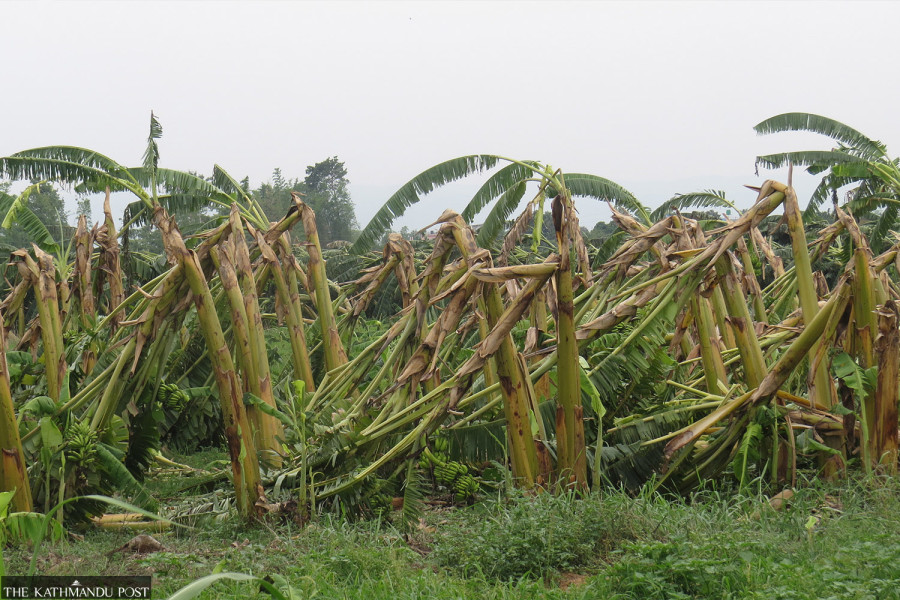Money
Powerful storm wipes out Chitwan’s banana crop
The Chitwan Banana Producers Association estimates damage could hover at Rs120 million, the largest ever losses.
Ramesh Kumar Paudel
A powerful storm on Friday and Saturday destroyed most of the banana crop in eastern Chitwan, the banana association said, claiming it was the worst loss the growers had ever faced.
The Chitwan Banana Producers Association has estimated that the damage could reach around Rs120 million.
With vast stretches of banana farms destroyed, producers warn of imminent shortages of bananas.
Ashika Malla of Tulsipur, Chitwan, who leases land and grows bananas on 11 bigah (7.45 hectares), said his crop would be ready for market in the next few weeks. But his hope shattered.
“Now, nobody will buy it. It’s neither matured nor ripened. It’s a big loss."
Malla has yet to assess the full extent of the damage.
Besides crop losses, he would need nearly Rs1 million to clear the fallen banana trees and plant new ones.
"It's a big blow,” said Bishnu Hari Panta, former president of the Chitwan Banana Producers Association.
Farmers say there are considerable economic consequences for this sector because only a few banana plants are left standing in the eastern part of Chitwan. It would take about seven months to start production again, and even then, it would not be back to normal.
Farmers have suffered loss, and they could face a double whammy. For the last one and a half years, most have not received insurance payouts.
"We are not sure of getting the insurance payout anytime soon," said Panta.
"Farmers are in big distress," he said, adding that the government should immediately release the insurance payout.
In Chitwan, banana plantation covers 3,500 bigha (2,370 hectares).
Most of the plantations are in the eastern part of Chitwan.
"The eastern part of Chiwan suffered a big loss. The loss in the western part, however, is nominal," said Janak Raj Pant, general secretary of the association.
Experts say that climate change is making storms more intense and devastating.
Apart from droughts and floods, storms and hailstorms are also increasing in Nepal and are considered a major climate-related disaster.
According to the National Climate Change Survey 2022, the second of its kind, released by the National Statistics Office recently, the economic losses in both farm and off-farm sectors in the last five years, as reported by households, excluding significant infrastructure damages, amounted to Rs415.44 billion.
The survey report said that drought had been reported as the major disaster, affecting 65.4 percent of households, followed by diseases and insects at 54.3 percent, storms at 46.2 percent, hailstorms at 32.6 percent, floods at 28.5 percent, cold waves at 21.7 percent, landslides at 21.5 percent, and inundation at 17.5 percent.
Farmers in Chitwan lament the government’s policy on insurance.
Since March 14, non-life insurance companies have stopped settling claims for insured farm products after failing to receive government premium subsidies.
The government is yet to clear around Rs3 billion under this heading to non-life insurance companies.
“The non-payment issue in the agriculture sector has put us in difficulties. Since companies have totally stopped farm insurance, it will erode the confidence of the farmers towards insurance,” Pujan Adhikary, director of the insurance development and promotion division of the Nepal Insurance Authority, recently told a meeting.
“Smallholder farmers and rural communities cannot manage climate risks by themselves without adequate financial instruments.”
Crop insurance was introduced in Nepal with much fanfare. The government has been formulating directives to implement crop and livestock insurance since January 2013.
Under the scheme, the government provided a 50 percent subsidy on the premium in the first year and raised it to 75 percent in the second year.
The premium subsidy was again reduced to 50 percent and raised to 80 percent in 2021.
When the insurance scheme started ten years ago, there were 802 claims. In the last fiscal year, the annual claims reached 36,000.
The Ministry for Agriculture and Livestock Development said that the insurance scheme resumed on May 30 following a meeting chaired by Agriculture Minister Jwala Kumari Sah. In a statement, the ministry said it would immediately release Rs970 million to the insurance companies, and the remaining dues will be settled within this fiscal year or by mid-July.
“The insurance companies have agreed to resume the scheme,” the ministry said in a statement.




 19.12°C Kathmandu
19.12°C Kathmandu1.jpg)














